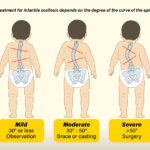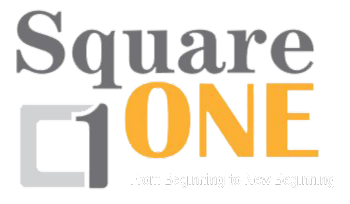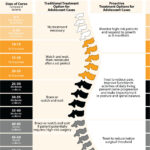A Guide To Understanding The Scoliosis Degrees Of Curvature Chart
Scoliosis is a condition that affects the spine, causing it to curve abnormally. It can cause pain, muscle weakness, and mobility issues. To determine whether a person has scoliosis and how far it has progressed, doctors use the Cobb angle to measure the spinal curvature of a patient.
The Cobb angle is a standard measurement expressed in degrees used to determine the progression of the spinal curvature.
Doctors then use the scoliosis degrees of curvature chart to track and evaluate the curvature in the spine. The degrees of curvature chart categorizes the severity of scoliosis by assigning a degree of curvature number. The higher the degree, the more severe the curvature and the greater the risk of serious medical complications.
The spinal curvature has to be at least 10° with rotation for a doctor to diagnose scoliosis. The Cobb angle, therefore, helps doctors identify if someone has scoliosis, how far it has progressed, or if it has worsened over time. This information is critical to determining how to treat the condition effectively.
Severity Level And Treatment Options For Scoliosis
The degree of curvature in the spine is a significant factor in determining the severity level and therefore treatment options for scoliosis. The treatment options will vary significantly depending on the degree of curvature in the spine, the age of the patient, and the overall health of their spine.
With that in mind, the following are the primary levels of severity and the respective treatment options:
- Mild Scoliosis: Mild scoliosis is defined as a curvature of less than 25°. Curves under 25° may not require treatment, however conservative treatment may be recommended. Observation only to see if the curves progress may be an option..
- Moderate Scoliosis: Moderate scoliosis is defined as a curvature between 25° and 40°. At this stage, a doctor may suggest scoliosis-specific exercises, bracing, or a combination of both.
- Severe Scoliosis: Severe scoliosis is defined as a curvature of greater than 40°. In addition to bracing and scoliosis-specific exercises, a doctor may recommend surgery to correct the curvature of the spine.
Two Main Scoliosis Treatment Approaches
Although doctors that treat scoliosis use the same chart to measure the degree of curvature and to determine the severity level of the condition, there are two basic approaches to treating scoliosis. The first is an observational or “traditional” approach. In contrast, the second is a proactive approach.
The Traditional Approach – Observation
A doctor that takes an observational approach to treating scoliosis will monitor the curvature of the patient’s spine and wait until it reaches a certain degree of curvature before taking action.
It’s a more reactive approach to treatment – the doctor will treat the condition based on how it’s progressing, which means this is a “wait and see” method. Treatment tends to be limited to pain medication, or treatments focused on pain reduction such as chiropractic, physical therapy, and spinal injections.
The Proactive Approach
The proactive approach to scoliosis treatment is more active and aggressive. The doctor will begin treatment as close to the time of diagnosis as possible. Instead of reacting to the progression of the condition, doctors using this approach focus on preventing the curvature from getting worse and keeping the spine as close to its natural shape as possible.
Proactive therapy focuses on scoliosis specific exercises, stretches, and bracing to help slow or stop progression, reshape the spine and reduce the curvature.
Although there are different approaches to proactive reatment, the right treatment plan doesn’t just depend on the severity of the scoliosis and the curvature, but also the patient’s age and overall health.
The following section outlines the scoliosis degree of curvature for four different age groups: infantile, juvenile, adolescent, and adult.
Infantile Scoliosis Degree Of Curvature
Infantile idiopathic scoliosis (IIS) specifically refers to scoliosis diagnosed in infants. Because their bones and muscles are still developing, IIS can be more challenging to treat than adult or adolescent scoliosis. As such, the degrees of curvature chart is slightly different.
For example, curvatures measuring 25° to 30° are considered moderate in adolescents but still mild in infants, and any curve under 60° in an adolescent can still be treated without surgery, whereas surgery is likely required for infants whose curvatures measure above 50°.

diagram demonstrating mild, moderate, and severe scoliosis in infants
Diagnosing Infantile Idiopathic Scoliosis
Children with scoliosis can be diagnosed with IIS up to the age of three. To accurately diagnose IIS, doctors use special imaging techniques such as x-rays and MRIs to measure the degree of the curvature. They will then rule out any potential underlying conditions before diagnosing the condition as “idiopathic,” which means it has no known cause.
The following are the treatment options for IIS depending on the degree of the curvature:
Mild Infantile Scoliosis
Mild IIS is diagnosed when the spinal curvature is less than 30°. Because infants are in a stage of rapid growth, doctors usually take an observation approach, as the condition may not progress. Most doctors will monitor the curvature and reassess every three to six or 12 months to check for any changes.
Moderate Infantile Scoliosis
Moderate IIS is diagnosed when the spinal curvature is between 30° and 50°. At this point, the doctor will recommend bracing or casting to help prevent the curvature from worsening. A brace is a special device designed to hold the spine in place while it’s still developing. It applies pressure on the spine to help reshape it and keep the curvature from progressing.
Casting is similar to bracing and helps to keep the spine in place as the child develops, and can also prevent any further progression of the curvature. Both bracing and casting are highly effective in successfully treating IIS during this stage of development.
Severe Infantile Scoliosis
Severe IIS is diagnosed when the spinal curvature is greater than 50°. Bracing and casting are still options at this point, although the doctor may also recommend surgery. Surgery is usually only used as a last resort after all other treatments have failed. There are several types of surgery that a doctor may recommend for infants with severe scoliosis, including:
- Growing Rods: This surgical procedure involves inserting adjustable rods into the spine to help realign and support it as the child grows. The surgeon can remotely lengthen the rods as the child develops, allowing for a more gradual curvature correction.
- Spinal Fusion: This surgical procedure involves fusing two or more vertebrae together to create a solid column of bone. Doing so helps realign the spine and prevent the curvature from worsening. Spinal fusion is usually only performed once the growing rods have been removed.
Juvenile Idiopathic Scoliosis Degree Of Curvature
Although more common than infantile scoliosis, juvenile idiopathic scoliosis (JIS) is less common than adolescent scoliosis. JIS is a bit different from infantile and adolescent scoliosis because it occurs in children when their spines aren’t experiencing as much growth.
Although doctors will still use the degrees of curvature chart to measure the severity of the curvature, the way they determine the best course of treatment may not be the same as the way they would for adolescent scoliosis.
However, as their spines are flexible during this stage, it means there is a high likelihood of success when it comes to treating children with scoliosis in this age bracket.
Diagnosing Juvenile Idiopathic Scoliosis
JIS is diagnosed in children between the ages of four and 10. Diagnosing children at this age is critical because they have a high risk of progression to more severe curvatures – even if their curvature is mild at the time of diagnosis. However, if treated properly, the progression can be stopped and the curvature can be reduced.
Mild Juvenile Scoliosis
Mild JIS is diagnosed when the spinal curvature measures between 10° and 25°. Many doctors take a traditional approach to mild JIS, which means the treatment is usually just observation. Doctors are often hesitant to prescribe any kind of treatment because of the child’s age.
For example, they may not prescribe bracing because braces (like the Boston brace) can cause some discomfort for children. Doctors who use this traditional approach usually reevaluate the curvature every few months with physical examinations and x-rays to check for any changes or progression.
If the curvature remains stable over time, no additional treatment is usually required. However, if progression is observed, casting or bracing may be recommended.
For doctors using a more proactive approach, the goal is to stop the progression in the first place and begin working on curvature reduction, even if the curvature is mild. They do this by prescribing scoliosis-based exercises (if a child is able to do them) that are appropriate for the child’s age.
Doctors may also recommend a part-time brace or night brace, scoliosis-specific exercises, or both.
Moderate Juvenile Scoliosis
Moderate JIS is diagnosed when the spinal curvature is between 25° and 45°. In these cases, bracing or casting may be necessary to help prevent further progression of the curvature. Bracing is the more common option for young children as it allows them to remain active while wearing the brace.
In some cases, the doctor may recommend that the bracing or casting be discontinued for a year or so if progression has stopped. The child will be observed during this period to ensure the curvature does not get worse. In some cases, surgery may be recommended if the brace doesn’t stop the curvature from progressing despite wearing a brace.
Severe Juvenile Scoliosis
Any curvature that measures over 45° is considered severe. Children diagnosed with severe JIS need to be treated immediately. As a result, surgery will likely be recommended for cases of severe JIS. Because children with JIS will soon reach adolescence, during which they will experience a growth spurt, growing rods may be used.
Growing rods provide extra support to the spine and can be adjusted as the child grows, allowing the spine to continue growing while keeping the curvature in check.
Adolescent Idiopathic Scoliosis Degree Of Curvature
Adolescent idiopathic scoliosis (AIS) is a condition diagnosed in adolescents over the age of 10. The condition is more likely to progress during this stage of development because of the growth spurt adolescents experience during puberty.
The following is the degrees of curvature chart used specifically for adolescents with AIS:
Diagnosing Adolescent Idiopathic Scoliosis
Like other forms of idiopathic scoliosis, there is no significant difference between the conditions. It’s called “adolescent” idiopathic scoliosis because it is diagnosed when the patient is between the ages of 11 and 18. With that in mind, the following are the three categories of curvature severity for AIS:
Mild Adolescent Scoliosis
Mild AIS is diagnosed when the spinal curvature measures between 10° and 25°. Doctors using a more traditional approach will wait and observe the patient’s progress before recommending any kind of treatment. They will monitor for any progression carefully, especially if the child is in the midst of a growth spurt.
Doctors typically schedule regular appointments to evaluate the child every three, six, or 12 months.
Because AIS occurs when children experience rapid growth, many doctors will take a more proactive approach. In addition to closely monitoring the progression, they may prescribe scoliosis-specific exercises, part-time bracing or both to help slow the progression of the curvature, prevent further worsening and possible reducing the curve size.
Moderate Adolescent Scoliosis
Moderate AIS is diagnosed when the spinal curvature measures between 25° and 45°. Doctors that take a traditional approach will recommend treatment in the form of bracing. There are many types of braces that can effectively reduce scoliosis curvatures, including part-time braces and full-time braces. Curves over 25° require full-time brace wear.
One of the most common types of braces prescribed in traditional treatment is the Boston brace, which is meant to slow or stop the progression of the condition, although not necessarily correct the curvature and it’s not custom made for each patient.. Scolibrace is a more corrective brace as it’s customized, puts the patient in true 3-D correction, and can make curve corrections in some cases.
Doctors that take a proactive approach may also prescribe bracing, but they will incorporate scoliosis-specific exercises and stretches as well. They may also recommend chiropractic biophysics (CBP, a science-based treatment that combines chiropractic adjustments and posture exercises to help realign the spine).
Severe Adolescent Scoliosis
Severe AIS is diagnosed when the spinal curvature measures over 45°. Traditional treatments will involve further bracing and scoliosis-specific exercises. However, a doctor will recommend surgery if bracing does not stop the progression of the condition and the spinal curvature progresses to a 55-degree angle, 60° in the thoracic spine, and 50° in the lumbar spine.
A more proactive approach will involve a comprehensive treatment plan, including bracing, scoliosis-specific exercises, stretches, and CBP. The ScoliBrace is often preferred in these cases as it is designed to correct the curvature, not just prevent it from progressing.
The goal is to avoid surgery, but if the patient has a curvature that exceeds 60°, correction may no longer be possible and a spinal fusion may be recommended.
Adult Scoliosis Degree Of Curvature
When it comes to scoliosis in adults, progression tends to be a lot slower. This is because the spine has finished growing by adulthood. As a result, the way adult scoliosis is treated is often quite different than scoliosis in children. This is especially true when it comes to a more traditional approach to treating adult scoliosis.
Diagnosing Adult Scoliosis
Adult scoliosis is classified into two categories: idiopathic and De Novo Degenerative Scoliosis. Idiopathic scoliosis is often the result of a scoliosis that was present in adolesence and is still present into adulthood. Idiopathic scoliosis are frequently undiagnosed in adolescence.
This is more common than one might realize since some forms of AIS can be very mild, and doctors may not have noticed the curvature in the spine until it progressed during adulthood. Idiopathic scoliosis frequently becomes degenerative in adulthood causing them to progress.
On the other hand, De Novo degenerative scoliosis is a new scoliosis that forms in adulthood.
Degenerative scoliosis is more common in adults over 40 and is caused by degeneration of the facet joints in the spine, such as osteoarthritis and disc degeneration. With this in mind, the following are the treatment options for the different levels of severity in adult scoliosis:
Mild Adult Scoliosis
Mild adult scoliosis is diagnosed when the spinal curvature measures between 10° and 25°.
In a more traditional treatment approach, the doctor will monitor the progression of the curvature but won’t actively treat it. However, they may prescribe medications to the patient based on the level of discomfort or pain they are experiencing. Traditional chiropractic or physical therapy may also be prescribed to reduce pain.
Doctors who take a more functional approach may also rely on observation for smaller curvatures. However, if the patient is experiencing pain and discomfort, they may recommend scoliosis-based exercises and stretches, bracing, possibly combined with CBP, to help reduce the pain and correct the spine.
Moderate Adult Scoliosis
Moderate adult scoliosis is diagnosed when the spinal curvature measures between 25° and 40°. When it comes to more traditional approaches, doctors will continue to prescribe pain medications if required. Again chiropractic care and/or physical therapy may be prescribed for pain relief. Steroid injections or radiofrequency ablation may also be recommended.
However, doctors using a functional approach will be more likely to recommend a combination of scoliosis-specific exercises, stretches, and CBP to slow the progression of the condition and correct the spine. They may also recommend bracing.
Severe Adult Scoliosis
Severe adult scoliosis is diagnosed when the spinal curvature measures over 40°. Traditional treatment does not change and consists merely of observation, pain medications, chiropractic care, or physical therapy.
However, if the scoliosis is severe and the spinal curvature continues to progress, the doctor will recommend spinal fusion. Surgery will also be recommended as part of a functional approach, but only if the curvature reaches 60° and all efforts to decrease back pain fail.
Early Awareness Can Increase Treatment Success
Scoliosis is a condition that tends to progress, which means that both the curvature of the spine and the associated symptoms of scoliosis can worsen over time. This is especially true when it comes to scoliosis in adolescents because their spines are still developing.
As such, diagnosing scoliosis in the early stages is critical. The earlier scoliosis is diagnosed, the more successfully the condition can be treated to help correct the spine and prevent the progression of the condition.
No matter what type of scoliosis you have, our team can help you. Learn more about Square ONE Health on this page.

